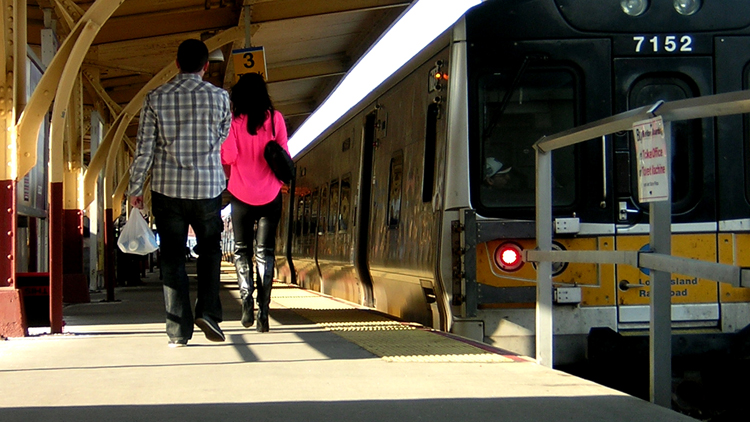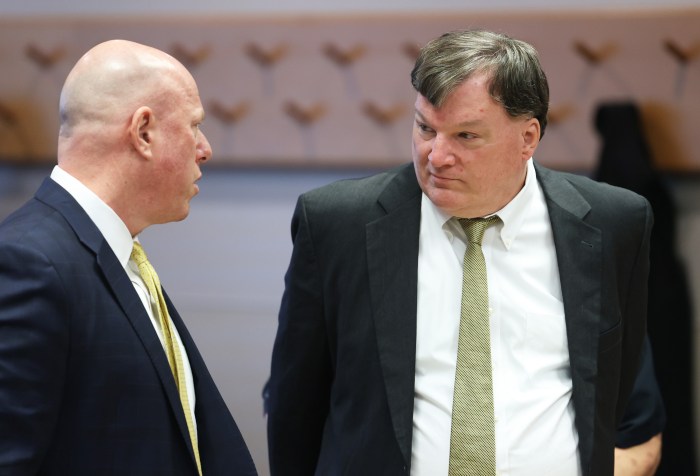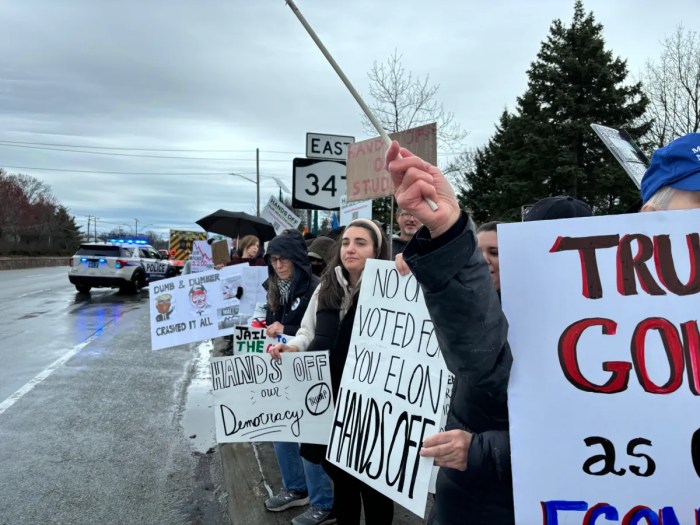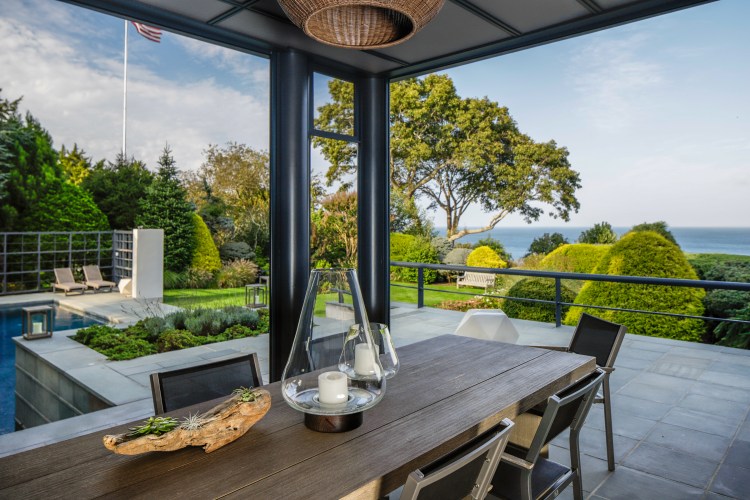While thousands of daily Long Island Rail Road commuters cope with service disruptions as Amtrak makes emergency repairs to Penn Station, this “Summer of Hell,” as Gov. Andrew Cuomo has dubbed the riders’ next two months, was about to become a dire season of stress for the LIRR because a final decision on its $2-billion third track project was suddenly delayed until the end of July—and its fate appeared in jeopardy.
But a late announcement Tuesday, July 11, from state Senate Majority Leader John J. Flanagan (R-East Northport) has put the proposal from the Metropolitan Transportation Authority for Long Island back on track.
As planned, the LIRR would add another track to its busy 9.8-mile corridor between Floral Park and Hicksville where four lines connect. And that’s where local resistance to the ambitious project had always been the staunchest, especially from village mayors and Republican state senators.
“All along, we have listened to our constituents and endeavored to do the right thing,” said Flanagan in a statement. “On behalf of the Senate Majority, Sen. Marty Golden [R-Brooklyn], our representative on the MTA’s Capital Program Review Board and a staunch advocate for the needs of his own community, will vote to allow the proposed ‘third track’ project to move forward.”
Late last month, rather than face a veto from the Republican state senator on the Capital Program Review Board, the MTA had withdrawn its amended $30 billion capital program, which included the third track plan, and then immediately resubmitted it to restart the clock and give the review board another 30 days to decide its fate.
The move had come after concerns reportedly arose that Sen. Golden, Flanagan’s proxy on the board, was going to nix the plan at the behest of Sen. Elaine Phillips (R-Flower Hill) and Sen. Kemp Hannon (R-Garden City), whose districts would be directly impacted by the third track’s construction.
After Flanagan announced his intention to approve the LIRR expansion, Phillips released a statement that she still has “serious concerns about the effect of this project on local residents and their quality-of-life.” She applauded “the diligent process” that the MTA had undertaken to address community issues but questioned its priorities.
“I strongly believe the MTA must strike an appropriate balance between fixing the problems responsible for the derailments, disruptions and delays that LIRR commuters have experienced and making the strategic investments necessary to facilitate the region’s continued growth,” she said. “Given the urgency of returning the system to a state of good repair, I believe that should be the immediate priority.”
Hannon’s office declined to comment, despite repeated requests.
Third track proponents had gotten a boost on June 30 when two of the plan’s most steadfast opponents, Floral Park Mayor Dominick Longobardi and New Hyde Park Mayor Lawrence Montreuil, said that because their local concerns had been mollified they signed a message of understanding (MOU) with the state. Oyster Bay Supervisor Joe Saladino, a Republican, also said that he favored the project.
That left its fate up to Flanagan, observed Kevin Law, president of the Long Island Association and a long-time advocate of the third track.
“Yes, he’s a local state senator but he’s also a statewide leader, and he really needs to do what’s in the best interests of the region,” Law said.
And on July 11 that’s what Flanagan said he’d do.
“From the outset, my only motivation has been to do what is right for Long Island commuters and their families, and for the hardworking taxpayers who live here,” he said in his statement. “There have always been short- and long-term issues to consider, and it was wrong for some to pit the promise of something new against incredibly important repairs that exist every day in the lives of real people and real taxpayers.”
Advocates for the third track say complicating the issue was that the two Nassau Republican senators had reportedly placed new demands on the governor in order to obtain their approval—“moving the goal posts,” as Newsday put it—which include getting increased hospital funding and preventing New York City from tapping dormant water wells in Queens because it could deplete Nassau’s aquifer.
In May, Cuomo had appointed Law to his Penn Station Task Force to address short- and long-term problems at the city’s transit hub. That’s why Law was on an afternoon task force conference call with the governor on July 7 to go over the MTA’s plans for the “Summer of Hell.”
“Part of the problem with the Summer of Hell that’s starting with Penn Station and Amtrak was the decades of neglect,” said Law. “Our system has had decades of neglect too. We’ve had the same two tracks that have existed since the 1800s when Long Island’s population was 50,000. We’re now 3 million people. This project’s been on the drawing board for 50 years.”
This most recent third track proposal got rolling in January 2016 when Cuomo announced his support to relieve the age-old bottleneck in the New Hyde Park-Hicksville corridor.
“There are a lot of connections in this one area,” said Mitch Pally, chief executive of the Long Island Builders Institute, a trade association, and a member of the MTA Board. “That’s what causes this section to probably be the most important 9.8 miles of all the miles that the Long Island Rail Road has, without a doubt.”
Law credits Cuomo with pushing the project over the goal line.
“Of course, the governor’s leadership on this was amazing because without him we wouldn’t have gotten this far,” said Law. “He could have easily have laid back and done what [Republican Gov. George] Pataki did and said: ‘All right, when you get everybody on board, let me know, and then I’ll climb on board.’”
To sweeten the pot—and soften community opposition to the third track plan—the governor had added almost a billion dollars that would, among other goals, eliminate seven street-level grade crossings; upgrade stations in Mineola, Garden City, New Hyde Park and Westbury; install six new parking garages; and provide off-site parking and a bus for construction workers so they wouldn’t occupy parking spots for commuters and local residents.
“You’ll have tremendous community benefits,” gushed Law, who noted that currently in New Hyde Park there’s an LIRR crossing where during rush hour the gates “are down 28 minutes of the hour and traffic backs up forever.”
Hannon had reportedly said the MTA should divert the money from the third track project to repair signals along the present tracks, which drew criticism from the proposal’s proponents who countered that there is no trade-off.
“Kemp is not wrong that there are some short-term items that need to be addressed but the fact of the matter is that we need to do both,” said Law. “We need the short-term solutions and the long-term investments.”
“Even if you upgraded the signals just in those areas, you still would not have enough capacity,” Pally explained. “Unless we do this third track, we will never be able to run more trains, ever.”
He noted that the LIRR has invested more than $10 billion in its East Side Access project—still several years away from completion—so it can send trains under the East River to Grand Central Terminal. Meanwhile the LIRR has broken ground on its Mid-Suffolk Yard so it can store trains in Islip. If the third track is finished, Pally said the LIRR would run 20 more trains every day just on the Ronkonkoma branch.
“We always complain about Long Island not getting its fair share, and now we finally
have a governor who’s willing to spend $2 billion,” Law exclaimed. “It would be fiscal malpractice for any elected official to stand in the way of these dollars coming into our region because it’s going to strengthen the Long Island economy for the foreseeable future.”
Barry LePatner, the author of Too Big to Fall: America’s Failing Infrastructure and the Way Forward, is skeptical that the LIRR’s third track will move people much faster on Long Island once it’s completed.
“You have a regional limitation on what can really be effective,” said LePatner, a corporate construction counsel in Manhattan. “And this $2 billion solution is not going to solve the major problems that are created by that regional limitation.”
Instead, he believes that the LIRR should think big and deploy a maglev train that uses high-speed rail to revolutionize the transit system for the decades ahead.
“Find another $40 billion and build the damn thing for our children and our grandchildren,” said LePatner. “This $2 billion is not going to make a significant difference.”
But in the present political world of Albany, it may be all the LIRR can hope to get—and even that amount was hanging by a thread until yesterday.
































